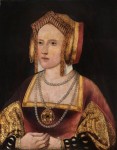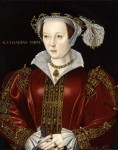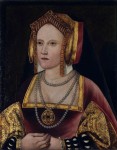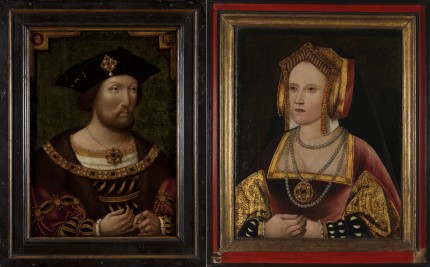For the first time since their world-altering acrimonious divorce, King Henry VIII and his first wife Catherine of Aragon have been reunited in painted form in London’s National Portrait Gallery. The early portrait of Henry VIII, painted around 1520 by an unknown Anglo-Dutch artist, has been in the NPG since 1969. The one of Catherine, on the other hand, is a relatively new discovery.
 In 2008, Gallery staff went to Lambeth Palace, the official London residence of the Archbishop of Canterbury, as part of the Making Art in Tudor Britain survey. They noticed a portrait of a woman in 1520s dress hanging in private sitting room. The subject was purportedly Catherine Parr, Henry VIII’s sixth and last wife, but the style of clothing and facial features were more reminiscent of Catherine of Aragon.
In 2008, Gallery staff went to Lambeth Palace, the official London residence of the Archbishop of Canterbury, as part of the Making Art in Tudor Britain survey. They noticed a portrait of a woman in 1520s dress hanging in private sitting room. The subject was purportedly Catherine Parr, Henry VIII’s sixth and last wife, but the style of clothing and facial features were more reminiscent of Catherine of Aragon.
The Gallery borrowed the painting to analyze it further in their conservation lab. They found that the original portrait had been considerably altered. Under raking light (bright light held at an angle against a surface) the black background was revealed to be an overlay covering what had once been a patterned background painted to look like damask silk. An X-ray clearly indicated that the black overlay was also covering up the veil attached to the headdress. An ultra violet digital photograph showed that the face and chest had been considerably repainted in past restorations. The eyebrows were strengthened, the nose narrowed with shadows, white added to the eyes and a curvy brown line painted between the lips to separate them.
 The analysis confirmed that this was not Catherine Parr, but rather a portrait of Catherine of Aragon from the 1520s. With that in mind, conservators worked painstakingly to remove the restorations. They removed the black overlay from the background to reveal the dark green damask pattern, a style very similar to the one in the background of the 1520 portrait of Henry VIII. They were also able to clean and remove the alterations to her face in stages. During the process they discovered diagonal lines of paint loss so strong that they would require the judicious application of translucent glazes to replace what was gone. From the strength of the paint loss and its focus on the face, experts believe the portrait was probably damaged deliberately.
The analysis confirmed that this was not Catherine Parr, but rather a portrait of Catherine of Aragon from the 1520s. With that in mind, conservators worked painstakingly to remove the restorations. They removed the black overlay from the background to reveal the dark green damask pattern, a style very similar to the one in the background of the 1520 portrait of Henry VIII. They were also able to clean and remove the alterations to her face in stages. During the process they discovered diagonal lines of paint loss so strong that they would require the judicious application of translucent glazes to replace what was gone. From the strength of the paint loss and its focus on the face, experts believe the portrait was probably damaged deliberately.
The frame also received some tender loving care from Gallery conservators. It’s a rare thing, the original engaged oak frame that was constructed around the panel before the portrait was painted, a sort of combo easel/frame. Even rarer was the survival of some of the original decorative finish underneath layers of paint and gilding applied over the centuries. Conservators were able to recover much of the original bands of color painted blue with azurite and red with vermillion.
 The finished product made a fine companion piece to the 1520s Henry VIII portrait. That’s not to say they were originally a paired set, but they’re from the same period, done in the same style and the same size. They’re examples of types of portraits that would have been copied and spread around, sometimes together, sometimes individually. If these two were ever together or at least paired with versions of each other, the last time was almost 500 years ago, before Catherine was banished from court in 1531.
The finished product made a fine companion piece to the 1520s Henry VIII portrait. That’s not to say they were originally a paired set, but they’re from the same period, done in the same style and the same size. They’re examples of types of portraits that would have been copied and spread around, sometimes together, sometimes individually. If these two were ever together or at least paired with versions of each other, the last time was almost 500 years ago, before Catherine was banished from court in 1531.
Dr Charlotte Bolland, Project Curator at the National Portrait Gallery, London says: “It is wonderful to have the opportunity to display this important early portrait of Catherine of Aragon at the Gallery. Henry VIII and Catherine of Aragon were married for nearly twenty four years and during that time their portraits would have been displayed together in this fashion, as king and queen of England.”

Henry and Catherine are reunited on the wall of Room 1. The exhibit is free to visitors and will run from January 25th to September 1st, 2013.